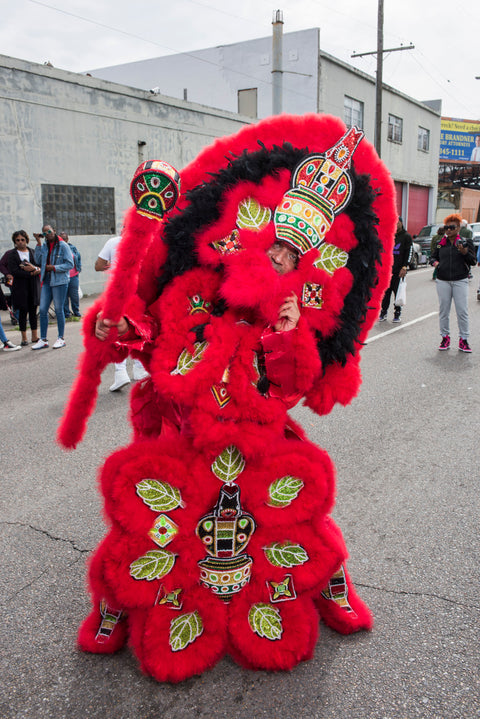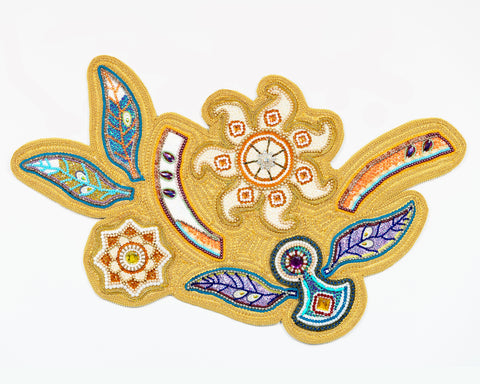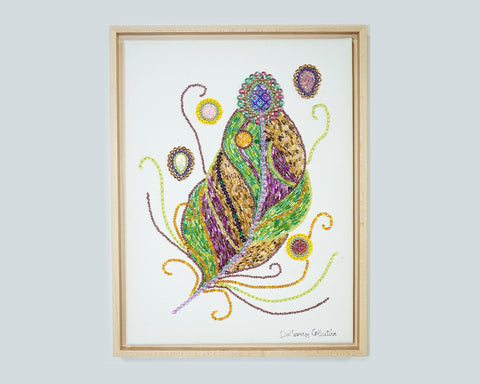Drop #4Summer 2022Brooklyn
DuVernay Collective: Reincarnation
Hailing from New Orleans, Charles DuVernay is a member of the Monogram Hunters, one of over forty tribes practicing Black Masking Indian culture.
For the debut collection of wall works, DuVernay deconstructed his feathered suits - originally worn as ceremonial garments in the Mardi Gras parade - and upcycled the intricately beaded patches by assembling them into eleven embroidered emblems that bare stories of hope, rebirth, and coexistence.
The DuVernay Collective’s work exemplifies a cultural blurring that contemporary artists are unafraid to tackle. Like...
Hailing from New Orleans, Charles DuVernay is a member of the Monogram Hunters, one of over forty tribes practicing Black Masking Indian culture.
For the debut collection of wall works, DuVernay deconstructed his feathered suits - originally worn as ceremonial garments in the Mardi Gras parade - and upcycled the intricately beaded patches by assembling them into eleven embroidered emblems that bare stories of hope, rebirth, and coexistence.
The DuVernay Collective’s work exemplifies a cultural blurring that contemporary artists are unafraid to tackle. Like sustainable fashion, they upcycle garments and redefine how their work is viewed. With their ability to reshape the established customs of Black Masking Indian traditions, they are developing a new subgenre of folk art based on history, community, and perseverance.
The tradition of Mardi Gras Indian suit making was born in response to the French colonial rule of Louisiana. Many black individuals who escaped their indentured servitude found refuge in indigenous communities, where they covertly traded goods, shared information, and eventually intermarried, hence the name “Black Masking Indian.” Half a century after the first New Orleans Mardi Gras parade took place in 1837, approximately fifty Plains Indians in native attire marched unannounced in the 1885 procession. It was an act of celebration and defiance. In subsequent years tribes consisting of both Native Americans and Africans began to form, and they later competed over whose big chief donned the grandest suit. Today the Mardis Gras tribes consist of two camps: the Uptown Indians, distinguished by their flat beaded works and depictions of Indigenous culture, and the Downtown Indians, who focus on abstraction and 3D construction.
As a member of the downtown “tribe” Monogram Hunters, Duvernay began sewing as a child. He returned to the practice as an adult and started designing his own suits in 2019. With beads and sequins individually sewn, each suit he assembled, with the support of the collective, took upwards of 900 hours to create. This labor of love is one of immense dedication, secret sewing techniques passed on from one generation to the next, and a testament to how legacy endures.
Encouraged by how a number of Uptown Indians were exploring other channels to reconstitute their work, DuVernay was inspired to take his grand suits, disassemble them and connect the patches into tapestries that tell stories about his community. Over the past year, Duvernay has developed this practice with his wife Jennie Wimbish and their close friend William McLain IV.
“Most [makers] spend thousands of hours on our suit-making, only to wear them once, maybe twice, never to be seen again,” says Charles DuVernay. “Our desire is to extend the artistic practice by giving our work a second life and [making] this heritage contemporary.”
Hailing from New Orleans, Charles DuVernay is a member of the Monogram Hunters, one of over forty tribes practicing Black Masking Indian culture.
For the debut collection of wall works, DuVernay deconstructed his feathered suits - originally worn as ceremonial garments in the Mardi Gras parade - and upcycled the intricately beaded patches by assembling them into eleven embroidered emblems that bare stories of hope, rebirth, and coexistence.
The DuVernay Collective’s work exemplifies a cultural blurring that contemporary artists are unafraid to tackle. Like...
Hailing from New Orleans, Charles DuVernay is a member of the Monogram Hunters, one of over forty tribes practicing Black Masking Indian culture.
For the debut collection of wall works, DuVernay deconstructed his feathered suits - originally worn as ceremonial garments in the Mardi Gras parade - and upcycled the intricately beaded patches by assembling them into eleven embroidered emblems that bare stories of hope, rebirth, and coexistence.
The DuVernay Collective’s work exemplifies a cultural blurring that contemporary artists are unafraid to tackle. Like sustainable fashion, they upcycle garments and redefine how their work is viewed. With their ability to reshape the established customs of Black Masking Indian traditions, they are developing a new subgenre of folk art based on history, community, and perseverance.
The tradition of Mardi Gras Indian suit making was born in response to the French colonial rule of Louisiana. Many black individuals who escaped their indentured servitude found refuge in indigenous communities, where they covertly traded goods, shared information, and eventually intermarried, hence the name “Black Masking Indian.” Half a century after the first New Orleans Mardi Gras parade took place in 1837, approximately fifty Plains Indians in native attire marched unannounced in the 1885 procession. It was an act of celebration and defiance. In subsequent years tribes consisting of both Native Americans and Africans began to form, and they later competed over whose big chief donned the grandest suit. Today the Mardis Gras tribes consist of two camps: the Uptown Indians, distinguished by their flat beaded works and depictions of Indigenous culture, and the Downtown Indians, who focus on abstraction and 3D construction.
As a member of the downtown “tribe” Monogram Hunters, Duvernay began sewing as a child. He returned to the practice as an adult and started designing his own suits in 2019. With beads and sequins individually sewn, each suit he assembled, with the support of the collective, took upwards of 900 hours to create. This labor of love is one of immense dedication, secret sewing techniques passed on from one generation to the next, and a testament to how legacy endures.
Encouraged by how a number of Uptown Indians were exploring other channels to reconstitute their work, DuVernay was inspired to take his grand suits, disassemble them and connect the patches into tapestries that tell stories about his community. Over the past year, Duvernay has developed this practice with his wife Jennie Wimbish and their close friend William McLain IV.
“Most [makers] spend thousands of hours on our suit-making, only to wear them once, maybe twice, never to be seen again,” says Charles DuVernay. “Our desire is to extend the artistic practice by giving our work a second life and [making] this heritage contemporary.”
“Our desire is to extend the artistic practice by giving our work a second life and make this heritage contemporary.”
— CHARLES DUVERNAY
Culture





















